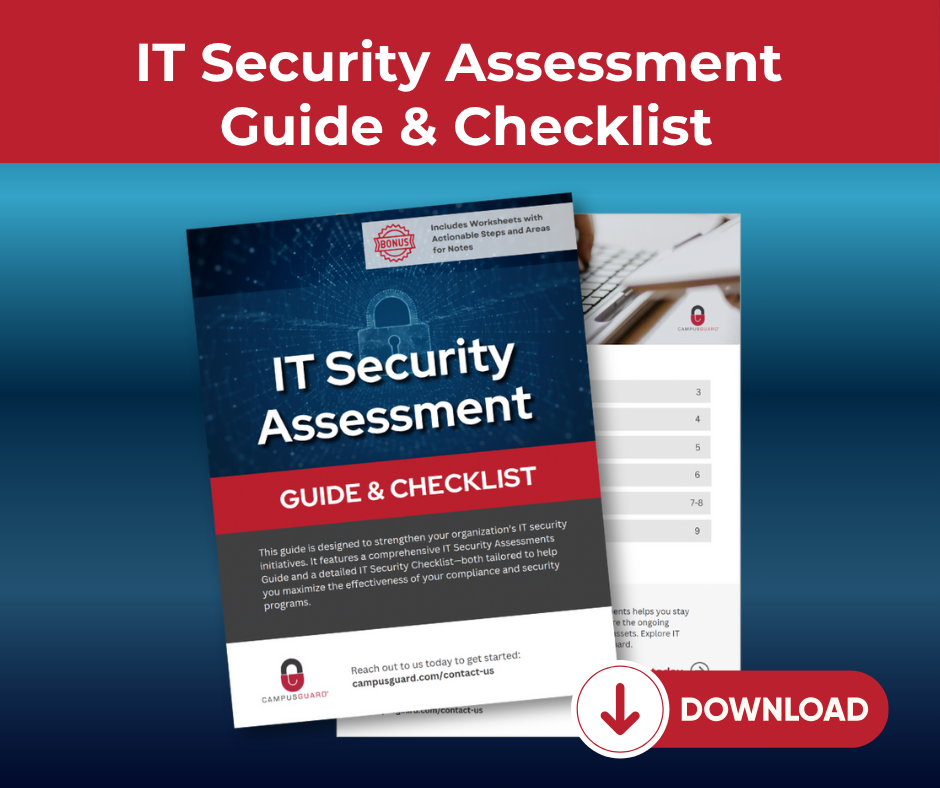
Boost the Security and Integrity of Your Valuable Data Assets
IT Security Assessments are an essential tool for your organization to efficiently review your security infrastructure, recognize potential deficiencies, mitigate risks, meet compliance requirements, instill customer confidence, and improve incident response.
Why Choose CampusGuard for your IT Security Assessment?
Our comprehensive IT Security assessment evaluates your organizational policies, processes, procedures, systems, and analysis of assets, threats, and vulnerabilities, including their impacts and probability.
IT Security Assessments: Evaluating and Mitigating IT Security Risks
In this video, we explore IT Risk Assessments and how they are used to evaluate possible risks and threats that could compromise the confidentiality, integrity, and availability of an organization’s data and systems.
The goal of a security assessment is to determine potential risks and provide recommendations to mitigate them.
A security assessment uses a variety of methods to identify vulnerabilities and threats, including vulnerability scanning, penetration testing, and social engineering, among others.
Benefits of IT Security Assessments
Engaging in an information security assessment, or IT Security assessment, is critical to protecting the integrity and security of an organization’s data assets. Conducting IT security assessments provides a myriad of benefits, including:
-
Identifying vulnerabilities
IT Security Assessments pinpoint an organization's weaknesses and deficiencies in their information systems and networks. Assessment results can assist in prioritizing security initiatives and allocating resources more effectively. -
Mitigating risks
After vulnerability detection, organizations can take actionable steps to mitigate the risks they pose. Potential solutions may consist of implementing new security measures, including access controls, firewalls, or intrusion detection systems. -
Meeting compliance requirements
Oftentimes, industries are required to meet regulations and standards consisting of annual, or periodic, IT security assessments. Engaging in IT security assessments assures that these requirements will be met, avoids costly fines, and demonstrates your organization's commitment to security. -
Enhancing incident response
With data breaches on the rise, organizations need to be proactive in ensuring they can respond to an incident quickly and effectively. Conducting regular assessments pinpoints potential gaps in your incident response plan and aids your teams in boosting your security incident preparedness.
Download the IT Security Assessment Guide & Checklist
Is your organization prepared for IT security risks? Download this free resource to confidently plan and manage your routine IT security assessments.
IT security doesn’t have to be overwhelming. This guide breaks it down into clear, actionable steps to help simplify your process and strengthen your defenses. It includes:
- Benefits of IT Security Assessments
- How to Conduct an IT Security Assessment
- IT Security Assessment FAQs
- IT Security Assessment Checklist
- Additional Help & Resources
Develop a Competitive Edge in Today's Digital Landscape
Engaging in annual security assessments helps you stay ahead of emerging threats and ensure the ongoing protection of your organization's IT assets.
Top IT Security Assessment FAQs
An IT security assessment gauges an organization's IT infrastructure, systems, and practices to pinpoint security deficiencies and determine the effectiveness of its security controls. The goal of an IT security assessment is to establish possible risks and threats that could compromise the confidentiality, integrity, and availability of an organization's data and systems.
An IT audit evaluates the overall effectiveness and efficiency of an organization's IT systems, processes, and controls. It aims to identify any weaknesses or areas for improvement in the IT infrastructure and make recommendations for improvement.
An IT Security Assessment evaluates the security posture of an organization's IT systems and identifies potential vulnerabilities and threats. The goal of a security assessment is to determine potential risks and provide recommendations to mitigate them. A security assessment uses a variety of methods to identify vulnerabilities and threats, including vulnerability scanning, penetration testing, and social engineering, among others.
Our comprehensive, multi-step process for conducting an IT Security Assessment includes:
- Pre-Assessment Document Gathering
- Assessment Scheduling
- Network Discovery and Vulnerability Scanning (if applicable)
- Assessment and Gap Analysis
- Optional Onsite includes Travel and Living Expenses
- Report of Findings Development, Internal Review, and Delivery
- Report Review Call
- Report Edits/Clarifications/Updates
- Final Report Delivery
Defining an IT Security Baseline
With your organization's information security environment constantly changing, the best way to detect a risk to your network is to establish an information security baseline using a consistent cybersecurity framework.
Read More about the Defining an IT Security Baseline

